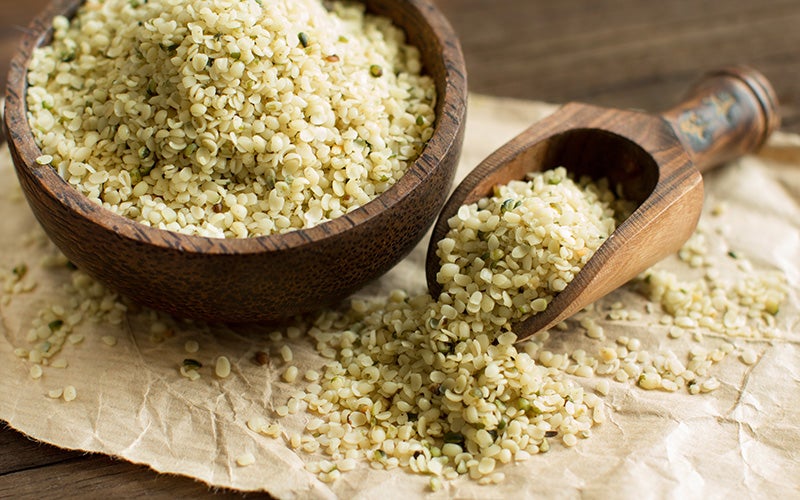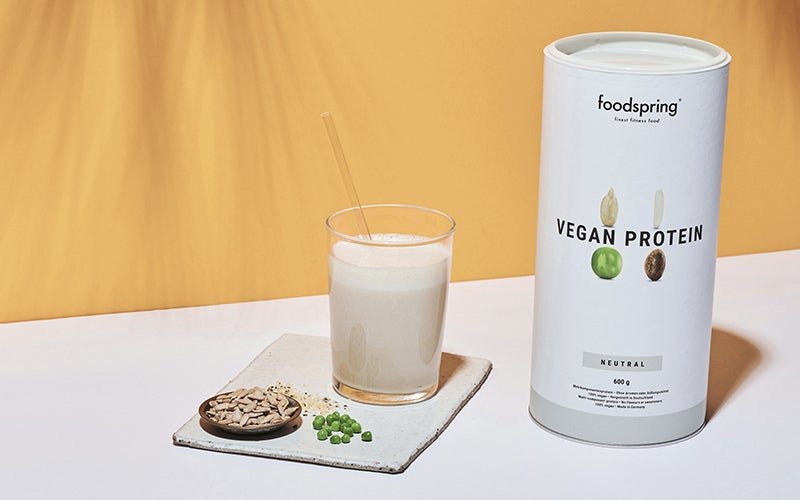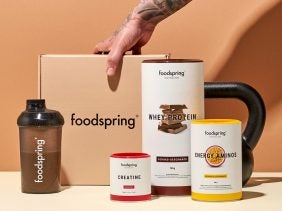Discover hemp seeds: health powerhouses rich in nutrients
 ©Karisssa
©Karisssa
They don’t look like much, but hemp seeds are skyrocketing to fame, thanks to their stellar nutrition profile. In this article, we tell you everything you need to know about these superfood superstars.
What is the difference between hemp and hemp seeds?
Numerous non-psychoactive cannabis products, from CBD (cannabidiol) to hemp seeds, are having a big moment right now because of both their flavors and relaxing properties. But the question remains: What makes the hemp seed different from hemp itself?
Hemp belongs to the cannabaceae family (dicotyledonous plants) and produces both a female form, which is larger and more leafy, and a male form that ripens earlier. It’s probably one of the oldest plants used in the world as it’s part of a storied medicinal tradition.
The plant produces the flower marijuana, which is well known for its psychoactive effects. Hashish, on the other hand, isn’t made with the flower – it’s created with the resin or pollen that comes off of the plant. Marijuana and hashish are among the drugs and psychoactive substances listed on the sites of the Interministerial Mission for the Fight against Drugs and Addictive Behavior (MILDECA). The possession, cultivation and trade of such substances are therefore prohibited in some parts of the world, but it’s becoming legalized for recreational and medicinal use in others.
However, this probably has you wondering why hemp seeds are often sold at the supermarket, often alongside common household products. That’s because a hemp seed doesn’t contain THC (tetrahydrocannabinol), the substance with the strongest psychoactive and hallucinogenic effect. Hemp seeds on their own will have no effect on your state of being.
Benefits of hemp seeds
Vegetarians, and vegans in particular, have been big fans of hemp seeds because they’re plant-based and protein-rich. Find out everything you need to know about the health benefits of hemp seed from our nutrition table below.
Shelled hemp seeds (100 grams)
| Calories | 553 |
| Protein | 31g |
| Carbohydrates | 9g |
| Fiber | 4g |
| Sugar | 1.5g |
| Fat | 49g |
| Saturated fat | 4.5g |
| Monounsaturated fatty acids | 5g |
| Polyunsaturated fatty acids | 38g |
Our tip: If you’re a vegan or vegetarian and are looking for plant-based protein sources, our Vegan Protein is a great option! It has all the essential amino acids you need thanks to a combination of pea, rice, sunflower, and hemp proteins.

These seeds are rich in nutrients
Hemp seeds have been touted as the latest ‘superfood’ because of how many nutrients they contain. Many claim they can promote weight loss, muscle development, and lower cholesterol and blood sugar levels. Unfortunately, there isn’t enough scientific evidence to prove these effects.
Our suggestion? Incorporate hemp seeds into your diet in moderation, because even if they’re beneficial effects aren’t proven, there are also no known adverse side effects. Like other nuts and seeds, hemp seeds are rich in essential fatty acids. Just 100 grams contains 39 grams of polyunsaturated fatty acids, which are commonly known as healthy fats. In Europe, the DGE (German Nutrition Society), says that these seeds may reduce risks of coronary heart disease and levels of harmful LDL cholesterol.
The small seeds of the hemp plant also contain various valuable vitamins, fiber, and minerals, including plenty of calcium and magnesium. The former is necessary for ensuring the functioning of body cells and preventing blood clotting, among other things, while the latter is a vital component of many enzyme systems in the body. These seeds are also rich in vitamin E and vitamin B, in addition to being excellent sources of omega-3 and omega and omega-6.
They’re also easily digested and absorbed by the body, and they’re even easier to incorporate into your food whether shelled or unshelled. An unshelled hemp seed is a bit crispier and richer in fiber thanks to that extra layer of thin, woody bark. And fiber is believed to promote satiety and encourage regular digestion.
What to know before buying hemp seeds
When shopping for hemp seeds, pay attention to the quality and origin as you would with any other healthy product. Although a hemp seed doesn’t contain THC, it can come into contact with parts of the plant during the harvest that are quite rich in THC and can therefore carry trace amounts.
If you live in the EU, there’s no need to worry because only hemp with a THC level below 0.2 percent is allowed to be grown in the first place. In general, avoid exceeding the recommended amount of THC to prevent possible adverse health effects.
Here are the THC indicative values for food and beverages:
- 5 µg/kg for non-alcoholic and alcoholic drinks
- 5000 µg/kg for edible oils
- 150 µg/kg for all other food products
Pregnant people, children, and heavy consumers of hemp seeds should practice caution. It’s better to opt for flax and sesame seeds and nuts some of the time than hemp seeds all of the time.
Cooking with hemp seeds
If you’d like to cook with hemp seeds but aren’t exactly sure how to use them, we can help. Rich in omega-3 and omega-6 fatty acids and fiber, and containing almost all the essential amino acids, they can be eaten in their pure state: raw and unpeeled. They are slightly oily and have a light, nutty flavor. Hemp seeds are an ideal garnish for salads or muesli, but can also be used as an ingredient to make sauces for pasta dishes and breading for fried foods.
Our tip: Use hemp seeds to add even more protein to our Protein Bread.
With a little know-how, you can easily whip up a delicious side dish made with hemp seeds, like tofu nuggets or chicken wraps.
Here’s a healthy recipe starring hemp seeds:
Carrots with honey and hemp (serves 2)
Ingredients: 300 g of carrots, 1 tablespoon of hemp seed oil, ¼ bunch of parsley, 1 teaspoon of honey, 1 tablespoon of hemp seeds, salt, grated nutmeg
Preparation:
- Brown the hemp seeds in a non-stick pan until lightly browned. Season with salt.
- While seeds are cooling, peel and chop carrots.
- Heat hemp oil in a saucepan, then add 3 tablespoons of water and carrots.
- Cover and cook over medium heat for about 10 minutes, then season with salt, nutmeg and chopped parsley.
- Set the pan aside and mix the honey with the carrots.
- Last step: arrange the carrots and garnish them with hemp seeds.
Do you prefer to satisfy your sweet tooth with healthy treats? Then this recipe might interest you:
Hemp seed energy bar
Ingredients: Mix of almonds, walnuts, and Brazil nuts (150g in total), 50g oatmeal, 200g dates, 50g chocolate protein, 3 tablespoons hemp seeds, 1 tablespoon coconut oil, 1 tablespoon maple syrup, a pinch of cinnamon, turmeric, and salt
Preparation:
- Before you begin, soak almonds, walnuts, and brazil nuts overnight. Dates should also be soaked for half an hour before making the dough.
- Chop the nuts and dates, cut the chocolate into small pieces, and mix all the ingredients together by hand.
- You can also save yourself the trouble of cutting the ingredients by simply putting them in a food processor and pulsing it two or three times. The whole process will take about 10 seconds.
- Line a cake tin or baking dish with parchment paper. Press the paste into the dish to form a flat, even dough.
- Let it chill in the freezer for about an hour. When it’s firm, you can dig in.
Hemp seeds: our conclusion
- Hemp seeds can be eaten pure or used to garnish various dishes.
- They do not contain THC and are therefore commercially available.
- They’re packed with nutrients including but not limited to amino acids like omega-3 and omega-6.
Sources for this article
We at foodspring use only high-quality sources, including peer-reviewed studies, to support the facts within our articles. Read our editorial policy to learn more about how we fact-check and keep our content accurate, reliable, and trustworthy.
- Bundesgesundheitsministerium (German Health Ministry) (2019): Cannabis https://www.bundesgesundheitsministerium.de/fileadmin/Dateien/5_Publikationen/Drogen_und_Sucht/Berichte/Hoch_et_al_Cannabis_Potential_u_Risiko_SS.pdf
- Deutsche Hauptstelle für Suchtfragen (2020): Cannabis https://www.dhs.de/suchtstoffe-verhalten/illegale-drogen/cannabis
- Bundeszentrum für Ernährung (2020): Hanf https://www.bzfe.de/inhalt/hanf-6580.html
- Bundeszentrum für Ernährung (2020): Trendlebensmittel Hanf https://www.bzfe.de/inhalt/trendlebensmittel-hanf-35193.html
- U.S. Department of Agriculture (2020): Seeds, hemp seed, hulled https://fdc.nal.usda.gov/fdc-app.html#/food-details/170148/nutrients
- Verbraucherzentrale (2019): Hanfsamen, Hanföl, Hanf-Tee – wie steht es mit der Sicherheit? https://www.verbraucherzentrale.de/wissen/lebensmittel/kennzeichnung-und-inhaltsstoffe/hanfsamen-hanfoel-hanftee-wie-steht-es-mit-der-sicherheit-12881
- BfR (2000): BgVV empfiehlt Richtwerte für THC (Tetrahydrocannabinol) in hanfhaltigen Lebensmitteln https://www.bfr.bund.de/de/presseinformation/2000/07/bgvv_empfiehlt_richtwerte_fuer_thc__tetrahydrocannabinol__in_hanfhaltigen_lebensmitteln-884.html

































